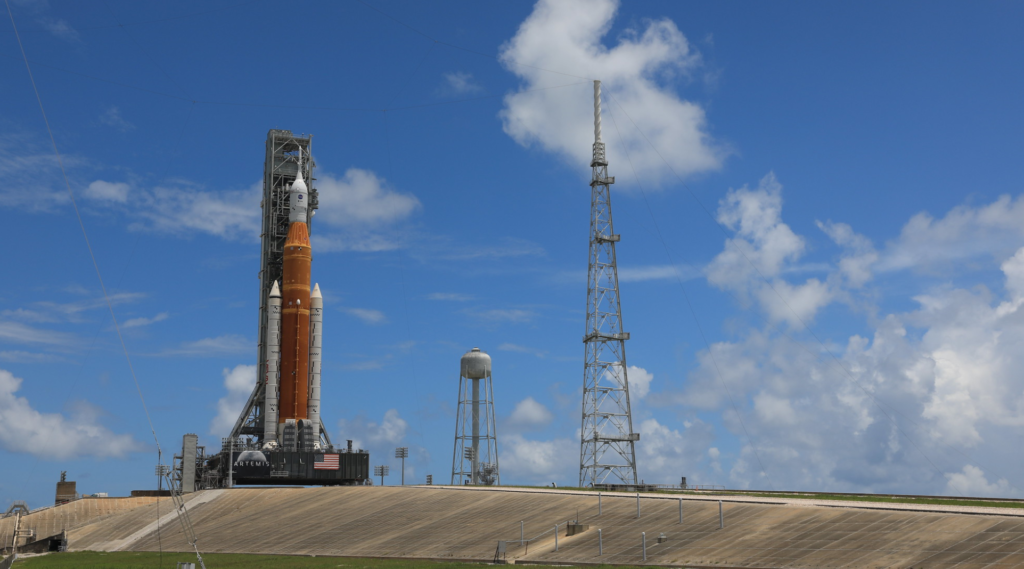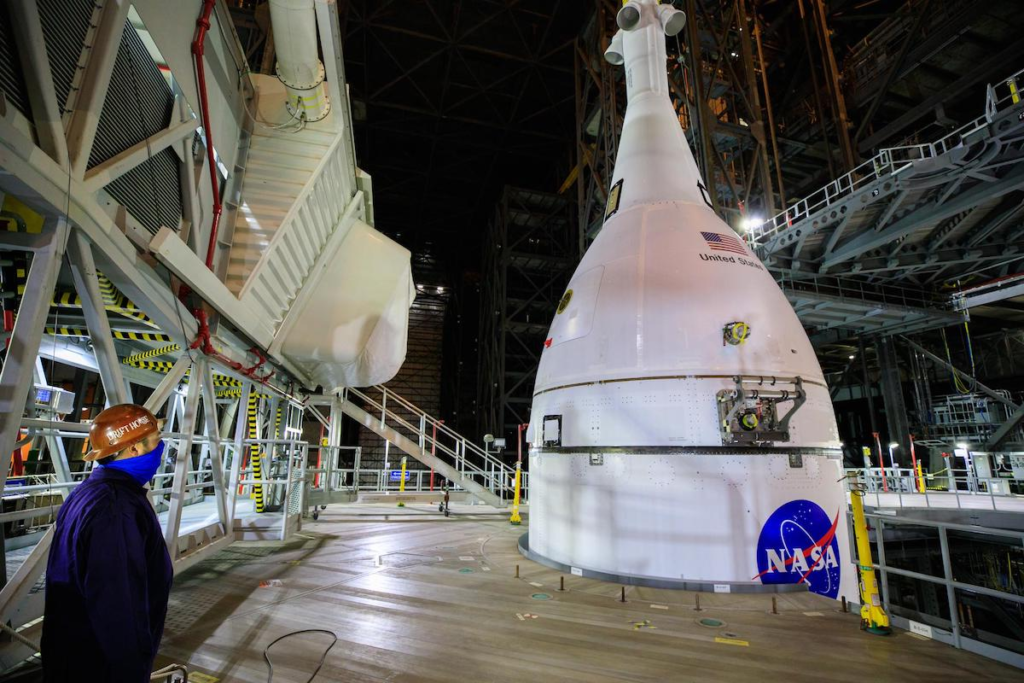
More Updates As NASA Gets Closer To The First Launch Of SLS
For months now we have watched a host of different missions and progress updates on projects all related to returning humans to the surface of the Moon. Apart of Artemis, NASA not only wants to return humans but set up a more permanent presence. This is why they are working with so many different companies and agencies for this ambitious project.
One of the most important projects is the Space Launch System or SLS rocket. This next generation launch vehicle is intended to help transport both crew and cargo to and from the Moon for years to come. After a long wet dress rehearsal, the agency is working on the final preparations for the first launch of the rocket.
Artemis 1 will test not only the launch vehicle itself but also the ground systems and the Orion spacecraft. If the multiple issues discovered during the wet dress rehearsal are all fixed within a short period of time, we can expect to see this rocket take off for the first time in only a few months if not less. Here I will go more in-depth into the recent updates from NASA, what to expect in the coming months, and more.
Recent Updates

Final work continues to prepare the Space Launch System rocket and Orion spacecraft at NASA’s Kennedy Space Center in Florida for Artemis I. Teams have identified placeholder dates for potential launch opportunities. These dates include late August into early September. Technicians now are testing the newly replaced seals on the quick disconnect of the tail service mast umbilical to ensure there are no additional leaks. The seals were replaced to address a hydrogen leak during the final wet dress rehearsal in June. Following testing, teams will complete closeouts to ready that section for flight.
More specifically, during work to repair the source of a hydrogen leak, engineers identified a loose fitting on the inside wall of the rocket’s engine section, where the quick disconnect for the liquid hydrogen umbilical attaches. The component, called a “collet,” is a fist-sized ring that guides the quick disconnect during assembly operations. Teams will repair the collet by entering the engine section in parallel with other planned work for launch preparations. Technicians have replaced the seals on the quick disconnect of the tail service mast umbilical and will reattach the umbilical plate once the loose collet is addressed. NASA continues to target the late August launch period and will identify a specific target launch date after engineers have examined the collet.
In addition, technicians continue work associated with battery activations. Teams installed the batteries for the solid rocket boosters and interim cryogenic propulsion stage this week and will install the core stage batteries next week. Next up, teams will start the flight termination systems operations, which include removing the core stage and booster safe and arm devices for calibration and removing and replacing the command receiver decoders with the flight units. The safe and arm devices are a manual mechanism that put the flight termination system in either a “safe” or “arm” configuration while the command receiver decoders receive and decode the command on the rocket if the system is activated.
In other updates, NASA will host a pair of briefings on Wednesday, Aug. 3, and Friday, Aug. 5, to preview the upcoming Artemis I lunar mission. The agency is currently targeting no earlier than Monday, Aug. 29, for the launch of the Space Launch System rocket to send the Orion spacecraft around the Moon and back to Earth. The mission will take place over the course of about six weeks to check out systems before crew fly aboard on Artemis II.
Artemis 1 Overview

Now that we know some of the progress NASA is making and the launch dates they are targeting, we can take a closer look at this mission. Artemis 1 begins by leaving Earth. SLS and Orion will blast off from Launch Complex 39B at NASA’s modernized spaceport at Kennedy Space Center in Florida. The SLS rocket is designed for missions beyond low-Earth orbit carrying crew or cargo to the Moon and beyond, and will produce 8.8 million pounds of thrust during liftoff and ascent to loft a vehicle weighing nearly six million pounds to orbit. Propelled by a pair of five segment boosters and four RS-25 engines, the rocket will reach the period of greatest atmospheric force within ninety seconds. After jettisoning the boosters, service module panels, and launch abort system, the core stage engines will shut down and the core stage will separate from the spacecraft. As the spacecraft makes an orbit of Earth, it will deploy its solar arrays and the Interim Cryogenic Propulsion Stage (ICPS) will give Orion the big push needed to leave Earth’s orbit and travel toward the Moon. From there, Orion will separate from the ICPS within about two hours after launch. The ICPS will then deploy a number of small satellites, known as CubeSats, to perform several experiments and technology demonstrations.
As Orion continues on its path from Earth’s orbit to the Moon, it will be propelled by a service module provided by the European Space Agency, which will supply the spacecraft’s main propulsion system and power (as well as house air and water for astronauts on future missions). Orion will pass through the Van Allen radiation belts, fly past the Global Positioning System (GPS) satellite constellation and above communication satellites in Earth orbit. To talk with mission control in Houston, Orion will switch from NASA’s Tracking and Data Relay Satellites system and communicate through the Deep Space Network. From here, Orion will continue to demonstrate its unique design to navigate, communicate, and operate in a deep space environment. The outbound trip to the Moon will take several days, during which time engineers will evaluate the spacecraft’s systems and, as needed, correct its trajectory. Orion will fly about 62 miles (100 km) above the surface of the Moon, and then use the Moon’s gravitational force to propel Orion into a new deep retrograde, or opposite, orbit about 40,000 miles (70,000 km) from the Moon.
For its return trip to Earth, Orion will do another close flyby that takes the spacecraft within about 60 miles of the Moon’s surface, the spacecraft will use another precisely timed engine firing of the European-provided service module in conjunction with the Moon’s gravity to accelerate back toward Earth. This maneuver will set the spacecraft on its trajectory back toward Earth to enter our planet’s atmosphere traveling at 25,000 mph (11 kilometers per second), producing temperatures of approximately 5,000 degrees Fahrenheit (2,760 degrees Celsius) – faster and hotter than Orion experienced during its 2014 flight test. After about three weeks and a total distance traveled exceeding 1.3 million miles, the mission will end with a test of Orion’s capability to return safely to the Earth as the spacecraft makes a precision landing within eyesight of the recovery ship off the coast of Baja, California. Following splashdown, Orion will remain powered for a period of time as divers from the U.S. Navy and operations teams from NASA’s Exploration Ground Systems approach in small boats from the waiting recovery ship. The divers will briefly inspect the spacecraft for hazards and hook up tending and tow lines, and then engineers will tow the capsule into the well-deck of the recovery ship to bring the spacecraft home.
With this first exploration mission, NASA is leading the next steps of human exploration into deep space where astronauts will build and begin testing the systems near the Moon needed for lunar surface missions and exploration to other destinations farther from Earth, including Mars. The second flight will take crew on a different trajectory and test Orion’s critical systems with humans aboard. The SLS rocket will evolve from an initial configuration capable of sending more than 26 metric tons to the Moon, to a final configuration that can send at least 45 metric tons. Together, Orion, SLS and the ground systems at Kennedy will attempt to meet the most challenging crew and cargo mission needs in deep space. Future exploration missions with crew aboard Orion will assemble and dock with a Gateway. NASA and its partners will use the gateway for deep-space operations including missions to and on the Moon with decreasing reliance on the Earth. Using lunar orbit, we will gain the experience necessary to extend human exploration farther into the solar system than ever before. All of which will be put to the test not long from now, starting with the first flight of SLS.
Conclusion
It has been a very long time since humans stepped foot on the Moon. NASA is working to not only return humans to the surface but set up a more permanent human presence. In order to complete such a feat, the agency is working on very ambitious projects and using different private companies for help as well. Recently NASA has given more updates on the progress of the Space Launch System. By now most of the repairs have been made and the launch vehicle is going through a few final checks. We will have to wait and see how it progresses and the impact it has on the space industry.
